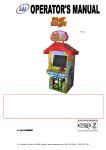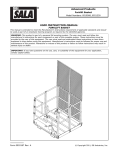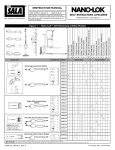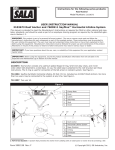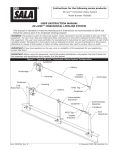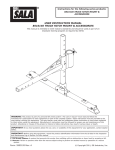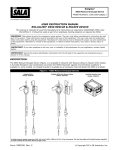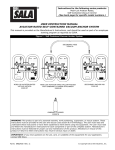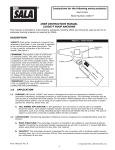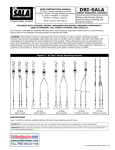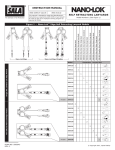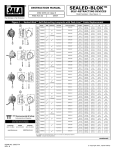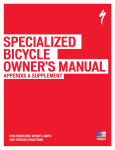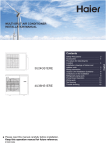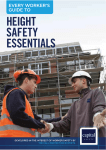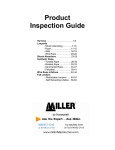Download ROpE-SAFE™ wITH ENERGy ABSORBER
Transcript
Rope-Safe™ with energy absorber Model Numbers: 8700570, 8700571, 8700572, 8700620, 8700621, 8700643, INSTRUCTION MANUAL The Ultimate in Fall Protection 1 Industrial 8700570 0.3m (1 ft) 8700571 Rope Access 8700620 0.3m (1 ft) 8700643 0.6m (2 ft) 8700572 0.6m (2 ft) 0.9m (3 ft) 8700621 0.9m (3 ft) 2 A B C D H I K L J E F G Figure 1 – Form no: 5903793 Rev: A © Copyright 2015, DB Industries, Inc. 3 4 H G A B B C D I C 5 F A B C D A E F E J 6 A B C D E F 2 G 7 C B A D 8 B A 9 A B 3 10 A B 11 A B 12 A J K E ANSI & OSHA Ø11 - 13mm ASNZS & EN Ø10.5 - 13mm B C H F G I 4 D 13 K L M N 14 A B 5 WARNING: This product is part of a personal fall arrest or restraint system. The user must follow the manufacturer’s instructions for each component of the system. These instructions must be provided to the user of this equipment. The user must read and understand these instructions before using this equipment. Manufacturer’s instructions must be followed for proper use and maintenance of this equipment. Alterations or misuse of this product or failure to follow instructions may result in serious injury or death. IMPORTANT: If you have questions on the use, care, or suitability of this equipment for your application, contact Capital Safety. IMPORTANT: Before using this equipment, record the product identification information (see Figure 2) in Table 2 - Inspection and Maintenance Log at the back of this manual. 1.0APPLICATIONS PURPOSE: The Rope-Safe™ with Energy Absorber (Figure 1) is designed to be used as an automatic or manual rope grab 1.1 as part of a fall arrest and/or restraint system for a single user working at heights. The Rope-Safe with Energy Absorber provides a portable connection point on a rope lifeline and includes an integral energy absorbing lanyard. The Rope-Safe operates as a “follower” while in automatic mode. Manual mode allows the user to “park” the Rope-Safe in position on the lifeline for work positioning or restraint. When “parked” the Rope-Safe can be moved up the lifeline towards the lifeline anchor but will lock in position on the lifeline if pulled down the lifeline by hand or by the energy absorbing lanyard. Models 8700620, 8700621, and 8700643 and can be towed in manual mode using the integral Tow Cord. Figure 2 illustrates key components of the Rope-Safe with Energy Absorber: A - UP Arrow Marking D - Operation Switch G - Swivel J - Instruction Labels B - Rope-Safe Housing E - Cover Button H - Carabiner K - Shock Absorbing Lanyard C - Cam Assist (Friction Cam) F - Tow Cord (if equipped) I - iSafe Product Label L - Shock Pack (Energy Absorber) 1.2Standards: The Rope-Safe with Energy Absorber is approved for use under the following standards: Standard User Max Weight* Application Users Standard User Max Weight* Application Users ANSI Z359.1 141kg (310lb) Fall Arrest 1 EN 12841 141kg (310lb) Fall Arrest 1 ANSI A10.32 141kg (310lb) Fall Arrest 1 EN 12841 200kg (440lb) Rescue 2 OSHA 1926.500 190kg (420lb) Fall Arrest 1 AS/NZS 1891.3 160kg (353lb) Fall Arrest 1 EN 353-2 141kg (310lb) Fall Arrest 1 * Maximum combined weight of user(s), clothes, tools, etc. 1.3 REscue Plan: When using this equipment the employer must have a rescue plan and the means at hand to implement and communicate that plan to users, authorized persons, and rescuers. 1.4Training: This equipment is intended to be used by persons trained in its correct application and use. It is the responsibility of the user to assure they are familiar with these instructions and are trained in the correct care and use of this equipment. Users must also be aware of the operating characteristics, application limits, and the consequences of improper use. Consideration should be given to the user’s age, fitness and physical or mental limitations that could have a detrimental affect on the safe use of this equipment. important: Training must be conducted without exposing the trainee to a fall hazard or must be used with backup fall protection. Training should be repeated on a periodic basis. 1.5 Inspection Frequency: See Section 5 of this manual for inspection frequency and procedures. 2.0 equipment Limitations & Requirements Always consider the following limitations and requirements when installing or using this equipment. 2.1 Rope type: The Rope-Safe with Energy Absorber is designed for use with synthetic kernmantle ropes (nylon, polyester or blends of both materials). Certified Rope Lifelines: Part Numbers for Rope Lengths 15m (50 ft) 30m (100 ft) 60m (200 ft) Material Description 11mm Rope Lifeline 8705115 8705116 8705117 13mm Rope Lifeline 8705122 8705123 8705124 Kernmantle Rope with polyester cover and nylon core. AS/NZS and EN: 10.5mm to 13mm (27/64 in. to 1/2 in.) Contact Capital Safety for other available rope lengths. ANSI and OSHA: 11 to 13mm (7/16 in. to 1/2 in.) warning: Use of incompatible rope (construction and/or size) mar result in serious injury or death when operating the Rope-Safe. Contact Capital Safety for other approved lifeline constructions. 2.2 free fall: Personal fall arrest systems must be rigged to limit a free fall to 1.8m (6.0 feet) or less when using the Rope-Safe with Energy Absorber. Restraint systems must be rigged so that vertical free fall is not possible. 2.3 FALL CLEARANCE: There must be sufficient clearance below the user to arrest a fall before the user strikes the ground or other obstruction. The clearance required depends on several factors: • Deployment distance • Free fall distance • Energy absorbing lanyard length • Elevation of anchorage • Movement of harness attachment element • Worker height • Lifeline elongation It is the user’s responsibility to calculate clearance based upon location, regional legislation, standards and situation. 6 Figure 3 illustrates Fall Clearance Parameters. A: Rope-Safe Connector Length 0.3m (1 ft) A: Rope-Safe Connector Length 0.6m (2 ft) A: Rope-Safe Connector Length 0.9m (3 ft) B: Lifeline Lengtha C: Fall Distance D: Lifeline Elongationb E: Safety Factor F: Required Fall Clearance 10m (33 ft) 1.8m (6.0 ft) 1m (3.3 ft) 1m (3.3 ft) 3.8m (12.5 ft) 25m (82 ft) 1.8m (6.0 ft) 2.5m (8.2 ft) 1m (3.3 ft) 5.3m (17.4 ft) 50m (164 ft) 1.8m (6.0 ft) 5m (16.4 ft) 1m (3.3 ft) 7.8m (25.6 ft) 100m (330 ft) 1.8m (6.0 ft) 10m (33 ft) 1m (3.3 ft) 12.8m (42.0 ft) B: Lifeline Lengtha C: Fall Distance D: Lifeline Elongationb E: Safety Factor F: Required Fall Clearance 10m (33 ft) 3.6m (11.9 ft) 1m (3.3 ft) 1m (3.3 ft) 5.6m (18.5 ft) 25m (82 ft) 3.6m (11.9 ft) 2.5m (8.2 ft) 1m (3.3 ft) 7.1m (23.4 ft) 50m (164 ft) 3.6m (11.9 ft) 5m (16.4 ft) 1m (3.3 ft) 9.6m (31.6 ft) 100m (330 ft) 3.6m (11.9 ft) 10m (33 ft) 1m (3.3 ft) 14.6m (48.2 ft) B: Lifeline Lengtha C: Fall Distance D: Lifeline Elongationb E: Safety Factor F: Required Fall Clearance 10m (33 ft) 4.5m (15 ft) 1m (3.3 ft) 1m (3.3 ft) 6.5m (21.6 ft) 25m (82 ft) 4.5m (15 ft) 2.5m (8.2 ft) 1m (3.3 ft) 8.0m (26.5 ft) 50m (164 ft) 4.5m (15 ft) 5m (16.4 ft) 1m (3.3 ft) 10.5m (34.7 ft) 100m (330 ft) 4.5m (15 ft) 10m (33 ft) 1m (3.3 ft) 15.5m (51.3 ft) G: Anchor Point H: Rope Lifeline I: Working Level J: Nearest Obstruction Example: If a user with the 0.6m (2 ft) Rope-Safe has a lifeline length of 15m (49 ft) above the Rope-Safe, the user will have a required fall clearance of 7.1m (23.4 ft). Required Clearance (F) = Fall Distance (C) + Lifeline Elongation (D) + Safety Factors (E) a Lifeline Length = Distance from Anchor Point to Fall Arrestor b Lifeline Stretch = 10% of Lifeline Length. Static Kernmantle rope will have a specific amount of stretch under the load of a fall as specified by the rope manufacturer and the standards body which it is manufactured under. Always take into consideration the stretch from the anchor point to the worker when calculating clearance. 2.4 SWING FALLS: Swing falls occur when the anchorage point is not directly above the point where a fall occurs. The force of striking an object in a swing fall may cause serious injury. In a swing fall, the total vertical fall distance will be greater than if the user had fallen directly below the anchorage point, thus increasing the fall clearance required to safely arrest the user. Minimize swing falls by working as directly below the anchorage point as possible. Never permit a swing fall if injury could occur. 2.5HAZARDS: Use of this equipment in areas with surrounding hazards exist may require additional precautions to reduce the possibility of injury to the user or damage to the equipment. Hazards may include, but are not limited to high heat, caustic chemicals, corrosive environments, high voltage power lines, explosive or toxic gases, sharp edges, moving machinery, or overhead materials that may fall and contact the user or fall arrest system. Avoid working where your lifeline may cross or tangle with that of another worker. Avoid working where an object may fall and strike the lifeline, resulting in a loss of balance or damage to the lifeline. Do not allow the lifeline to pass under arms or between legs. Warning: When working with tools, materials, or in high temperature environments, ensure that associated fall protection equipment can withstand high temperatures, or provide protection for those items. 2.6 COMPATIBILITY OF COMPONENTS: Capital Safety equipment is designed for use with Capital Safety approved components and subsystems only. Substitutions or replacements made with non-approved components or subsystems may jeopardize compatibility of equipment and may effect the safety and reliability of the complete system. 2.7 COMPATIBILITY OF CONNECTORS: Connectors are considered to be compatible with connecting elements when they have been designed to work together in such a way that their sizes and shapes do not cause their gate mechanisms to inadvertently open regardless of how they become oriented. Contact Capital Safety if you have any questions about compatibility. Connectors (hooks, carabiners, and D-rings) must be capable of supporting at least 22.2 kN (5,000 lbs.). Connectors must be compatible with the anchorage or other system components. Do not use equipment that is not compatible. Non-compatible connectors may unintentionally disengage (see Figure 4). Connectors must be compatible in size, shape, and strength. Selflocking snap hooks and carabiners are required. Use only the supplied carabiner and energy absorber. Do not remove the energy absorber or connector or add any other components in line. Warning: Use only supplied carabiner and energy absorber. Do not remove the energy absorber or connector or add any other components in line. 2.8 Making Connections: Use only connectors that are suitable to each application. Ensure all connections are compatible in size, shape and hook strength. Do not use equipment that is not compatible. Ensure all connectors are fully closed and locked. Capital Safety connectors (snap hooks and carabiners) are designed to be used only as specified in each product’s user’s instructions. See Figure 5 for inappropriate connections. Capital Safety snap hooks and carabiners should not be connected: A. To a D-ring to which another connector is attached. B. In a manner that would result in a load on the gate. Caution: Large throat snap hooks should not be connected to standard size D-rings or similar objects which will result in a load on the gate if the hook or D-ring twists or rotates. C. In a false engagement, where features that protrude from the snap hook or carabiner catch on the anchor, and without visual confirmation seems to be fully engaged to the anchor point. 7 D. To each other. E. Directly to webbing or rope lanyard or tie-back (unless the manufacturer’s instructions for both the lanyard and connector specifically allows such a connection). F. To any object which is shaped or dimensioned such that the snap hook or carabiner will not close and lock, or that roll-out could occur. G. In a manner that does not allow the connector to align properly while under load. 2.9 ANCHORAGE STRENGTH: Anchorages selected must have a strength capable of sustaining static loads applied in the directions permitted by the system of at least: ANSI Application Non-Certified Anchorage Fall Arrest 22.2kN (5,000 lbs) Two times the maximum arresting force Certified Anchorage Restraint 4.5kN (1,000 lbs) Two times the foreseeable force for certified anchorages Work Positioning 13.3kN (3,000 lbs) Two times the foreseeable force for certified anchorages Rescue 13.3kN (3,000 lbs) Five times the foreseeable force for certified anchorages AS/NZS Anchorage Fall Arrest, 1 user 15kN (3,400 lbs) Restraint, 1 user 12kN (2,700 lbs) Rescue, 2 users 21kN (3,400 lbs) Certified Anchorage: An anchorage for fall arrest, positioning, or rescue systems that a qualified person certifies to be capable of supporting the potential fall forces that could be incurred during a fall or that meet the criteria for certified anchorage prescribed by the associated standard(s). Multiple Systems: When more than system is attached to the anchorage, the strengths set forth shall be multiplied by the number of systems attached to the anchorage. From OSHA 1926.500 and 1910.66: Anchorages used for attachment of personal fall arrest systems shall be independent of any anchorage being used to support or suspend platforms, and capable of supporting at least 5,000 lbs. per user attached, or be designed, installed, and used as part of a complete personal fall arrest systems which maintains a safety factor of at least two, and is under the supervision of a qualified person. In Canada, refer to local regulations where applicable. IMPORTANT: Extreme working conditions (harsh environments, prolonged use, etc.) may require increasing the frequency of inspections. 3.0installation and use warning: Do not alter or intentionally misuse this equipment. Consult Capital Safety when using this equipment in combination with components or subsystems other than those described in this manual. Some subsystem and component combinations may interfere with the operation of this equipment. Use caution when using this equipment around moving machinery, electrical hazards, chemical hazards, sharp edges, or overhead materials that may fall onto the lifeline. Failure to heed this warning may result in equipment malfunction, serious injury, or death. WARNING: Consult your doctor if there is reason to doubt your fitness to safely absorb the shock from a fall arrest. Age and fitness seriously affect a worker’s ability to withstand falls. Pregnant women or minors must not use the fall arrester. 3.1Planning: Plan your fall protection or restraint system before starting your work. Account for all factors that may affect your safety before, during, and after a fall. Consider all requirements and limitations defined in this manual. 3.2 Inspection before use: See Section 5 of this manual for inspection frequency and procedures. 3.3 Connect rope lifeline to anchorage. Select a rigid anchorage point that is capable of supporting the required loads. See section 2.9 for list of required anchorage strengths per region. The anchorage location must be carefully selected to reduce possible free fall and swing fall hazards and to avoid striking an object during a fall. For restraint systems the anchorage must be located such that no vertical free fall is possible. The rope lifeline must meet requirements of section 2.1 and be free of knots,cuts, burns, severely abraded areas and excessive wear. The rope lifeline must be protected from contact with sharp or abrasive edges and surfaces. 3.4 CONNECT THE Rope-Safe with energy absorber to a rope lifeline: Never connect more than one personal fall arrest or restraint system to a single lifeline. The Rope-Safe uses a pivoting cover and locking internal cam to secure the Rope-Safe to the rope. (See Figure 6) A. Switch the Rope-Safe to automatic mode. (See Section 3.6 for Automatic and Manual Mode instructions,) B. Open the pivoting cover. Hold the Rope-Safe with the cover toward the user. Depress the cover button (grey button on rope side of the Rope-Safe. C. Swing the cover down to open. D. Continue to swing the cover down until the friction cam is completely exposed. E. Insert the rope lifeline between the friction cam and the Rope-Safe wall. F. With the rope lifeline completely within the Rope-Safe, pivot the cover closed until the cover button re-engages the cover. Never use a Rope-Safe with the cover in the open position or unlocked. G. Confirm that the Rope-Safe locks on the rope by pulling down on the swivel connector. Always confirm that the Rope-Safe is attached to the lifeline with the arrow pointing towards the anchor. 8 WARNING: Placing side loads on the Rope-Safe such as on a leading edge may result in damage to the unit, failure of the Rope-Safe to operate properly or cause the Rope-Safe to unlock on the lifeline, any of which could cause injury or death. 3.5 CONNECT THE Rope-Safe with energy absorber to the user’s harness: The Rope-Safe with Energy Absorber connects to the user’s harness with the energy absorbing lanyard and ANSI rated connector. The locking gate on the connector is a triple action lock that requires the user to lift, turn and then open the gate’s barrel. The gate automatically closes and locks. After allowing the gate to close, squeeze the gate of the carabiner to confirm that the lock has engaged. Consult the harness manufacturer’s instructions regarding connections and safe operation. Except under rescue conditions, never connect more than one person to a single Rope-Safe Fall Arrester. Harness connection point recommended for Rope-Safe with Energy Absorber models (See Figure 7): Rope-Safe Model Length Tow Cord 8700570 0.3M (1 ft) No Tow Cord 8700620 0.3M (1 ft) Tow Cord 8700571 0.6m (2 ft) No Tow Cord 8700643 0.6m (2 ft) Tow Cord 8700572 0.9m (3 ft) No Tow Cord 8700621 0.9m (3 ft) Tow Cord Recommended Harness Connection Point Front D-Ring Dorsal D-Ring Mode of Operation Shown in Figure 7 A Automatic Mode B Manual Mode C Automatic Mode D Manual Mode 3. 6 Rope-Safe with Energy Absorber Use Automatic and Manual Operation Modes: The Rope-Safe with Energy Absorber can be converted from automatic (follower) to manual (towable) mode. Automatic mode operation allows the Rope-Safe to be free to move on the rope lifeline. In automatic mode, the Rope-Safe will follow the user while the user is ascending and lead the user when the user is descending. Movement on the lifeline is allowed because the arresting cam is prevented from making direct contact with the lifeline (Figure 8 A). The cam will grip the lifeline (lock on the lifeline) when the swivel connector engages the cam (in the event of a fall) and contact is made with the lifeline (Figure 8 B). WARNING: Use of the Rope-Safe with Energy Absorber in automatic mode while working on porous or unstable granular surfaces, such as sand or grains, is not recommended. In the event of surface instability, the user might sink slowly and not gain enough momentum to cause the Rope-Safe to lock on the lifeline. The user could be enveloped, causing serious injury or death. In manual mode operation, the Rope-Safe can be used for fall arrest and/or restraint. The Rope-Safe can move on the rope lifeline in an upwards direction (toward the anchor) but remains locked when pulled downward (away from the anchor) by hand or by the Energy Absorber. Automatic and Manual Mode Selection. Switch from Automatic to Manual Mode: (See Figure 9) A. To switch from automatic mode to manual mode, depress the operation switch in the middle of the Rope-Safe. (Figure 9 A) The cam assist will lock on the rope. B. While in manual mode, pull down on the Rope-Safe with Energy Absorber to lock the Rope-Safe on the rope lifeline. (Figure 9 B) Switch from Manual to Automatic Mode when the Rope-Safe is locked on the rope lifeline: (See Figure 10): A. Reach into the top of the Rope-Safe with a single finger. (Figure 10 A) B. Push the cam assist forward toward the rope lifeline until it clicks into place, engaging the operation switch. (Figure 10 B) Once engaged, the cam assist will not contact the lifeline and the Rope-Safe can move freely on the lifeline. 3. 7Tow Cord Use (if equipped) in Manual Mode: (See Figure 11) Some Rope-Safe with Energy Absorber models include a tow cord. The tow cord can be used for lowering the Rope-Safe during manual operation. Gently pull on the tow cord to cause the Rope-Safe to begin to move lower on the lifeline. Figure 11 A shows the Rope-Safe being towed. Figure 11 B shows the Rope-Safe being towed with a descent device. If the user pulls too hard (as in a fall) the Rope-Safe will lock off and the tow cord will release at the breakaway fuse connection to the Rope-Safe. The Rope-Safe will then lock on the rope lifeline to prevent the user from descending. If the tow cord releases, the user can reconnect the tow cord by snapping the cylindrical connectors back together. Do no modify the tow cord in any way and do not attempt to bypass the breakaway fuse connection. Warning: Placing side loads on the Rope-Safe such as on a leading edge may result in damage to the unit, failure of the Rope-Safe to operate properly or cause the Rope-Safe to unlock on the lifeline, any of which could cause injury or death. 3. 8 after a fall: Any equipment which has been subjected to the forces of arresting a fall or exhibits damage consistent with the effect of fall arrest forces as described in Section 5 must be must be taken out of service immediately and destroyed to prevent further use. 4.0Training 4.1 It is the responsibility of all users of the Rope-Safe with Energy Absorber to understand these instructions and to be trained in the correct installation, use, and maintenance of the device. These users must be aware of the consequences of improper installation or use of this equipment. This user manual is not a substitute for a comprehensive training program. Training must be provided on a periodic basis to ensure proficiency of the users. Important: Training must be conducted without exposing the trainee to a fall hazard or must be used with backup fall protection. Training should be repeated on a periodic basis. 9 5.0Inspection The Rope-Safe with Energy Absorber must be visually and manually inspected by the user before and after each use. It must be inspected by a competent person every 6 months to verify that the device is operating correctly. If the Rope-Safe with Energy Absorber fails an inspection, has been used in an actual rescue (not training) and/or has seen the force of a fall, it must be taken out of service immediately and destroyed to prevent further use. 5.1 Unsafe or Defective conditions: If inspection reveals an unsafe or defective condition, remove the Rope-Safe with Energy Absorber from service and destroy it. IMPORTANT: The Rope-Safe with Energy Absorber is not repairable. Do not alter or attempt to repair the Rope-Safe with Energy Absorber. 5.2 Product Life: The functional life of the Rope-Safe with Energy Absorber is affected by work conditions and maintenance. As long as the product passes the inspection criteria described in Section 5 of this manual it may remain in service for a period of ten years from the date of manufacture, after which it must be removed from service. 5.3i-safe rfid tag: The Rope-Safe with Energy Absorber ID Label includes an i-Safe™ Radio Frequency Identification (RFID) tag (Figure 12, item K). The i-Safe™ RFID tag can be used in conjunction with the i-Safe handheld reading device and the web based portal to simplify inspection and inventory control and provide records for fall protection equipment. If you are a first-time user, contact a Customer Service representative in the US at 800-328-6146, in Australia at 1800 245 002 or in New Zealand at 0800 212 505. If you have already registered, go to: http://www.capitalsafety.com/en-us/Pages/i-Safe.aspx. Follow the instructions provided with the i-Safe handheld reader or on the web portal to transfer your data to the web log. Table 1 – Inspection Checklist See Figure 2 for Rope-Safe with Energy Absorber component identification. User Pass Fail Competent Person Pass Fail Confirm there are no cracks, corrosion or deformation to the housing or any other part of the Rope-Safe. All labels and markings must be present and legible. Inspect markings and labels on all components of the device including the device body and the label pack attached to the energy absorber. (See Figures 12 and 13.) Confirm that the carabiner is not bent, rusted/corroded or deformed, the gate opens and automatically closes and locks and that it is not gouged or nicked in a way that could damage the attached energy absorber. Confirm there is no corrosion, debris or other substances which could hamper the operation of the Rope-Safe. Closely examine the cam assist, cover button, operation switch and swivel to confirm that all are operating smoothly. Where debris or other substances have accumulated and affect the operation of the Rope-Safe, clean the Rope-Safe as described in Section 6. Operate the cover, confirming that it opens and closes smoothly. Confirm that the cover locks into place and only opens when the cover button is depressed. When closing the cover, invert the Rope-Safe and confirm that the gravity latch stops the cover from closing. (See Figure 14, item A) Open the cover and invert the Rope-Safe and confirm that the inertial cam flips down. Inspect the inertial cam to confirm it is not damaged and that it rotates freely.(See figure 14, item B) Attach the Rope-Safe to the rope lifeline and confirm that the Rope-Safe will lock on the lifeline when activated by the swivel connector. Depress the operation switch to confirm that it locks on the rope lifeline in manual mode. If equipped with a tow cord: with the Rope-Safe in manual mode, operate the Rope-Safe by pulling it down the rope lifeline using the tow cord. Switch the Rope-Safe back to automatic and confirm that it will follow the user without restriction. Confirm that there are no cuts, burns or damage to the lanyard material and that the energy absorber has not been deployed or damaged. After the rope lifeline is threaded into the Rope-Safe and prior to descending, put weight on the Rope-Safe to confirm that it locks onto the rope. While in manual mode, pull on the tow cord (if equipped) to confirm that descent can occur. The device includes an integrated energy absorbing lanyard and ANSI rated connector. If any component of the system is missing or replaced with a non-factory supplied component, the Rope-Safe with Energy Absorber must be removed from service. Record inspection dates and results in Table 2 - Inspection and Maintenance Log. Full Body Harness Inspect the Full Body Harness according to the manufacturer’s instructions. Rope Lifeline Inspect the Rope for knots, cuts, burns,severely abraded areas and excessive wear. Inspect the rope lifeline according to the manufacturers instructions. 10 6.0 Cleaning, Maintenance, and STORAGE 6.1 The Rope-Safe should be cleaned in clean lukewarm water and allowed to dry away from direct sunlight. Cleaning and drying should be carried out immediately after every use in a marine environment. Keep the Energy Absorber dry. Examine the Rope-Safe cam and cam assist to ensure any grit is removed and they are moving smoothly. A light cleaning agent such as WD-40 or equivalent may be used to remove grit, dirt and grime that may cause stiffness in the operation of the cam. When a cleaning agent is used, ensure that all remnants are washed off the Rope-Safe. Store in a clean, dry environment. Avoid temperature extremes, corrosive fumes or chemical substances. If the Rope-Safe with Energy Absorber comes into contact with chemicals refer to chemical data sheets and/or the manufacturer. When not in use or in transport, the Rope-Safe with Energy Absorber should be properly protected from the elements and whenever possible kept in a protective bag, dry and out of direct sunlight. When the Rope-Safe with Energy Absorber is used in extremely cold weather, be aware if there is a possibility of water/ice coming into contact with the moving parts of the Rope-Safe. Confirm that all Rope-Safe with Energy Absorber components are free of ice. Rope lifelines should not be stored in direct sunlight or where they may be affected by any heat source. Storage area humidity should be 60% and temperature should be approximately 75°F (24°C). Ropes should not come into contact with any chemicals and should be removed from service if they come into contact with chemicals outside the PH range of 5.5 – 8.5. 6.2 Clean and store all other system components according to the manufacturers’ instructions. 7.0specifications 8.0markings and labels Model Length Weight Tow Cord See Figure 12 8700570 0.3m (1 ft) 0.8kg (1.9 lb) No A Manufacturer’s name/Mark. G User must read instructions. 8700571 0.6m (2 ft) 0.9kg (2.0 lb) No B Part number/model. H Certifying agency. 8700572 0.9m (3 ft) 1.0kg (2.2 lb) No C Date of manufacture MM/YY. I Maximum rated load. D Serial number. J Do not remove energy absorber. Do not use without energy absorber. E Range of rope sizes and construction suitable for the Rope-Safe. K i-safe RFID tag is imbedded in the ID label. F Number and year of standard. 8700620 0.3m (1 ft) 0.8kg (1.9 lb) Yes 8700643 0.6m (2 ft) 0.9kg (2.0 lb) Yes 8700621 0.9m (3 ft) 1.0kg (2.2 lb) Yes See Figure 13 K Read user instructions. M Warnings (French) L Warnings N Inspection Log / User Information. Table 2 – Inspection and Maintenance Log SERIAL NUMBER: MODEL NUMBER: DATE PURCHASED: INSPECTION DATE DATE OF FIRST USE: INSPECTION ITEMS NOTED CORRECTIVE ACTION Approved By: Approved By: Approved By: Approved By: Approved By: Approved By: Approved By: Approved By: Approved By: 11 MAINTENANCE PERFORMED LIMITED LIFETIME WARRANTY Warranty to End User: CAPITAL SAFETY warrants to the original end user (“End User”) that its products are free from defects in materials and workmanship under normal use and service. This warranty extends for the lifetime of the product from the date the product is purchased by the End User, in new and unused condition, from a CAPITAL SAFETY authorised distributor. CAPITAL SAFETY’S entire liability to End User and End User’s exclusive remedy under this warranty is limited to the repair or replacement in kind of any defective product within its lifetime (as CAPITAL SAFETY in its sole discretion determines and deems appropriate). No oral or written information or advice given by CAPITAL SAFETY, its distributors, directors, officers, agents or employees shall create any different or additional warranties or in any way increase the scope of this warranty. CAPITAL SAFETY will not accept liability for defects that are the result of product abuse, misuse, alteration or modification, or for defects that are due to a failure to install, maintain, or use the product in accordance with the manufacturer’s instructions. THIS WARRANTY IS THE ONLY WARRANTY APPLICABLE TO OUR PRODUCTS AND IS IN LIEU OF ALL OTHER WARRANTIES AND LIABILITIES, EXPRESSED OR IMPLIED. LIMITED LIFETIME WARRANTY - AUSTRALIA Warranty to End User: Capital Safety Group (Australia) Pty Ltd (“Capital Safety”) warrants to the original end user (“End User”) that its products are free from defects in materials and workmanship under normal use and service. This warranty extends for the lifetime of the product from the date the product is purchased by the End User, in new and unused condition, from a Capital Safety authorized distributor. This warranty is provided in addition to other rights and remedies available to the End User under law. No oral or written information or advice given by Capital Safety, its distributors, directors, officers, agents or employees shall create any different or additional warranties or in any way increase the scope of this warranty. This warranty will not apply to and Capital Safety will not accept liability for defects that result from product abuse, misuse, alteration or modification, or for defects that are due to a failure to install, maintain or use the product according to the manufacturer’s instructions. Capital Safety’s warranty applies only to the End User. To obtain the benefit of this warranty, the End User must register the purchased product at capitalsafety.com.au under “Warranty Registration” tab, or retain their original receipt as proof of purchase. To claim under this warranty, the End User should return the product with an explanation of the product issue, along with the original proof of purchase, to: CAPITAL SAFETY AUSTRALIA 95 Derby Street, Silverwater, NSW 2128 Phone: 02 8753 7600/Toll free: 1800 245 002 Email: [email protected] The End User must pay the cost of packaging and returning the product to Capital Safety. Limitation of Warranty: The warranties stated in this document are exclusive and are made in place of any and all conditions, warranties or representations as to the merchantability, performance, quality or fitness for a particular purpose of the product that may be implied by law, and in place of any industry practice or custom or trade usage. The product comes with guarantees that cannot be excluded under Australian Consumer Law. The End User is entitled to a replacement or refund for a major failure and to compensation for any other reasonably foreseeable loss or damage. The End User is also entitled to have the product repaired or replaced if the product fails to be of acceptable quality and the failure does not amount to a major failure. Limitation of Liability: To the extent permitted by law: (a) Capital Safety’s maximum liability to the End User for failure to comply with a consumer guarantee in respect of the supply of the product not of a kind ordinarily acquired for personal, domestic or household use or consumption is limited, at Capital Safety’s sole discretion, to repair or replacement of the product; and (b) Capital Safety will not be liable for any direct, indirect, special, or consequential damages of any kind, including loss of profits, revenue or business, death, personal injury or damage to property resulting from or in any way related to Capital Safety’s products. Australia & New Zealand 95 Derby Street Silverwater Sydney NSW 2128 Australia Phone: +(61) 2 8753 7600 Toll-Free : 1800 245 002 (AUS) Toll-Free : 0800 212 505 (NZ) Brazil EMEA (Europe, Middle East, Africa) Fax: +(61) 2 8753 7603 Rua Anne Frank, 2621 EMEA Headquarters: [email protected] Boqueirão Curitiba PR 5a Merse Road Asia 81650-020 North Moons Moat Singapore: Brazil Redditch, Worcestershire 69, Ubi Road 1, #05-20 Phone: 0800-942-2300 B98 9HL UK [email protected] Phone: + 44 (0)1527 548 000 Oxley Bizhub Singapore 408731 Fax: + 44 (0)1527 591 000 Mexico Phone: +65 - 65587758 [email protected] Calle Norte 35, 895-E Fax: +65 - 65587058 Col. Industrial Vallejo [email protected] France: C.P. 02300 Azcapotzalco Le Broc Center Mexico D.F. Shanghai: Z.I. 1re Avenue - BP15 Phone: (55) 57194820 06511 Carros Le Broc Cedex Rm 1406, China Venturetech Plaza [email protected] 819 Nan Jing Xi Rd, France Shanghai 200041, P R China Phone: + 33 04 97 10 00 10 Colombia Phone: +86 21 62539050 Compañía Latinoamericana de Seguridad S.A.S. Fax: + 33 04 93 08 79 70 Fax: +86 21 62539060 Carrera 106 #15-25 Interior 105 Manzana 15 [email protected] [email protected] Zona Franca - Bogotá, Colombia USA 3833 SALA Way Red Wing, MN 55066-5005 Toll Free: 800.328.6146 Phone: 651.388.8282 Fax: 651.388.5065 [email protected] Canada 260 Export Boulevard Mississauga, ON L5S 1Y9 Phone: 905.795.9333 Toll-Free: 800.387.7484 Fax: 888.387.7484 [email protected] Phone: 57 1 6014777 [email protected] www.capitalsafety.com I S O 9001













